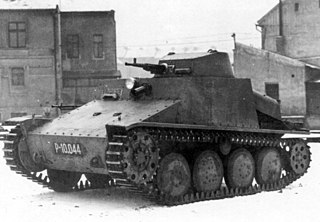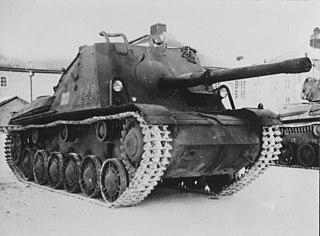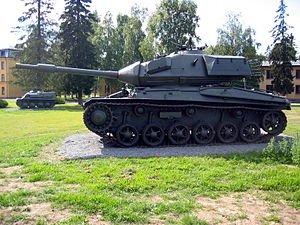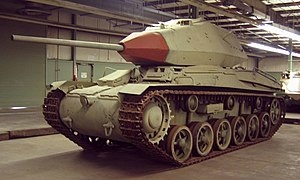
The Panzerkampfwagen IV, commonly known as the Panzer IV, is a German medium tank developed in the late 1930s and used extensively during the Second World War. Its ordnance inventory designation was Sd.Kfz. 161.

The Panzerkampfwagen 38(t), originally known as the ČKD LT vz. 38, was a tank designed during the 1930s, which saw extensive service during World War II. Developed in Czechoslovakia by ČKD, the type was adopted by Nazi Germany following the annexation of Czechoslovakia. With the German Army and other Axis forces, the type saw service in the invasions of Poland, France and the USSR. Production ended in 1942, when its main armament was deemed inadequate. In all, over 1,400 Pz. 38(t)s were manufactured. The chassis of the Pz. 38(t) continued to be produced for the Marder III (1942–1944) with some of its components used in the later Jagdpanzer 38 (1944–1945) tank destroyer and its derivative vehicles.

The Stridsvagn 103, also known as the Alternative S and S-tank, is a Swedish Cold War-era main battle tank, designed and manufactured in Sweden. "Strv" is the Swedish military abbreviation of stridsvagn, Swedish for chariot and tank, while the 103 comes from being the third tank in Swedish service to be equipped with a 10.5 cm gun.

The Centurion was the primary British Army main battle tank of the post-World War II period. Introduced in 1945, it is widely considered to be one of the most successful post-war tank designs, remaining in production into the 1960s, and seeing combat into the 1980s. The chassis was adapted for several other roles, and these variants have remained in service. It was a very popular tank with good armour, mobility, and a powerful main armament.

The Bofors 37 mm anti-tank gun was an anti-tank gun designed by Swedish manufacturer Bofors in the early 1930s originally for Swedish use. It was exported to several countries during the 1930s of which several bought licences to produce it themselves. The gun was used in several conflicts but most of its fame comes from its use in the Spanish Civil War and the Winter War where it was used very successfully against light tanks and armored cars among other targets. Beyond its use as an infantry gun it was also used as the main armament in several armored cars and tanks such as the Dutch M39 Pantserwagen and the Polish 7TP to name a few. As the armor of tanks was increased during World War II the gun very quickly became obsolete as an anti-tank gun but was still used effectively as an infantry support gun for the entirety of the war, and well into the Cold War. This was due to its high fire rate, great mobility and effective high explosive shells.

The infanterikanonvagn 91, lit. 'infantry cannon wagon 91', was a high mobility assault gun that was developed to meet the operational requirements of the Swedish Army. It was designed and manufactured by Hägglund & Söner and employed common components with the Pbv 302 armoured personnel carrier series. The first prototypes of the ikv 91 were completed in 1969 with production running from 1975 until 1978. In total, 212 were manufactured.

15,5 cm bandkanon 1, meaning "15.5 cm (6.1 in) tracked cannon 1", was a Swedish self-propelled artillery vehicle in use with the Swedish Army from 1967 to 2003, developed by Aktiebolaget Bofors. Its product name was Bofors Vagnkanon 155 mm L/50, meaning roughly "Tracked Automotive Gun 155 mm L/50". Bkan 1 was one of the world's heaviest and most powerful self-propelled artillery vehicles in use during its service.

Stridsvagn 122 is a Swedish main battle tank that, like the German Leopard 2A5, is based on the German Leopard 2 improved variant utilizing such newer technology as command, control, and fire-control systems, reinforced armour, and long-term combat capacity. Externally, the vehicle is distinguished from the Leopard 2A5 by the French GALIX smoke dispensers, different storage bins, and the thicker crew hatches.

Stridsvagn m/41 was a Swedish medium tank. A license-built version of the Czechoslovak TNH medium tank, it served into the 1950s.

The Leichter Kampfwagen II, commonly known as the LK II, was a light tank designed and produced in limited numbers in Germany in the last year of World War I. A development of the LK I, it incorporated a fixed rear superstructure and had two distinct configurations; one variant being armed with the MG 08/15, and the other being armed with a 5.7 cm Maxim-Nordenfelt gun. Its armor was 8 to 14 mm thick, which led to a total weight of 8.75 tons. Power was provided by a Daimler-Benz Model 1910 4-cylinder 55-60 hp gasoline engine, giving a maximum speed of 14 to 18 km/h with range of 65–70 km.

Stridsvagn m/42 was a Swedish medium tank in service in the World War II period. Known by its manufacturer AB Landsverk as Lago II-III-IV, it fielded a 75 mm L/31 gun, the first of its size in a Swedish tank. It entered service with the Swedish Army in April 1943. Modern in design and mobile, a total of 282 were produced.

The Landsverk L-60 was a Swedish tank developed in 1934. It was developed by AB Landsverk as a light tank which included several advanced design features such as torsion bar suspension, periscopes rather than view slits and all-welded construction.

Stridsvagn m/37 was a Swedish-built version of the Czechoslovak ČKD AH-IV tankette.

The AH-IV was a Czechoslovak-designed export armored fighting vehicle, classed as either a tankette or light tank, used by Romania during World War II, but having also been acquired by neutral Sweden and Iran. Modified AH-IV versions were built under license by Romania (R-1) and Sweden. The Romanian vehicles saw action on the Eastern Front from Operation Barbarossa to the Vienna offensive. Twenty vehicles were sold after the war to Ethiopia, who used them until the 1980s.

Landsverk L-10 was a Swedish late interwar era medium tank constructed by AB Landsverk for the Swedish Army between 1930 and 1933.

The T1 light tank was a United States Army light tank of the late 1920s and early 1930s that was only built in prototype form. The tank was an Army design built by James Cunningham, Son and Company. Introduced in 1927, it was developed up through 1932 as a series of modified versions. The tank was never mass-produced, nor was it ever used in combat.

This article deals with the history and development of tanks employed by the military of Sweden, from the interwar period, and World War II, the Cold War and modern era.

The Pansarvärnskanonvagn m/43 was a tank destroyer developed by Landsverk.

Landsverk L-30 was a Swedish late interwar era medium tank constructed by AB Landsverk for the Swedish Army between 1930 and 1935, featuring welded armour joints and a "wheel-cum-track system", allowing for interchangeable wheeled and tracked propulsion.




















